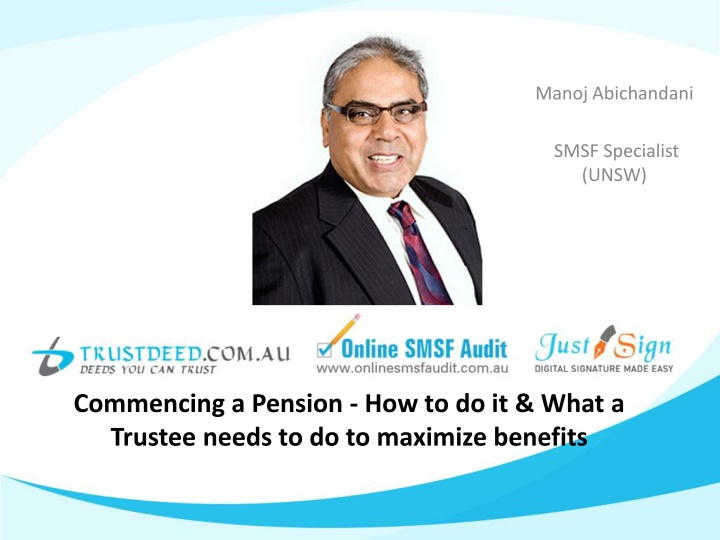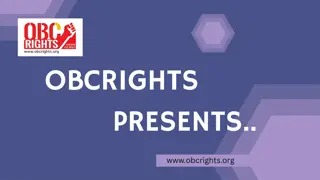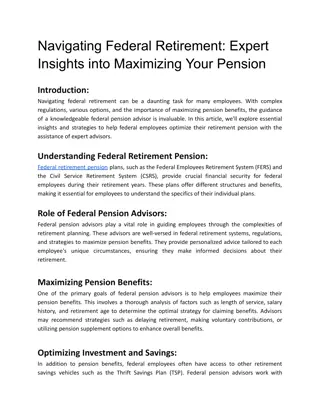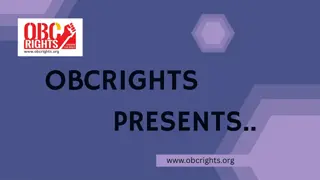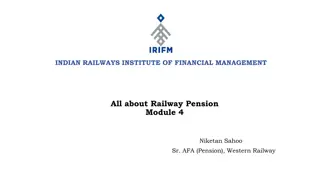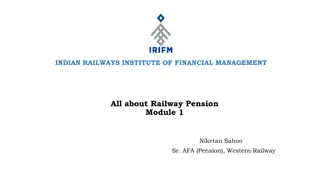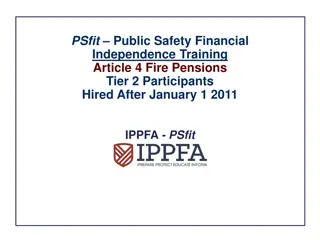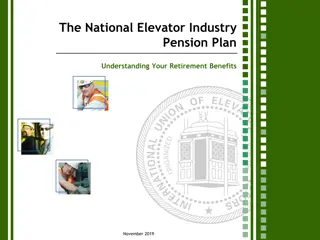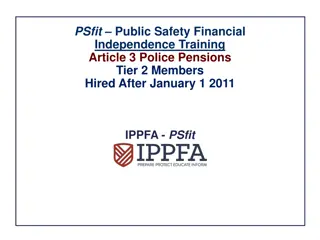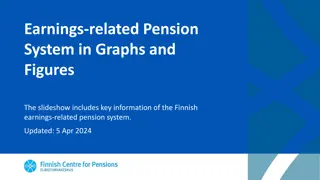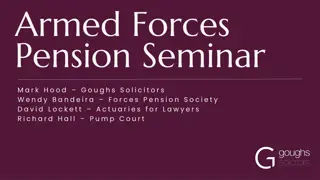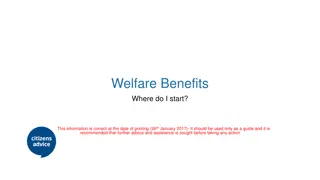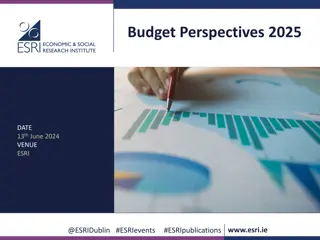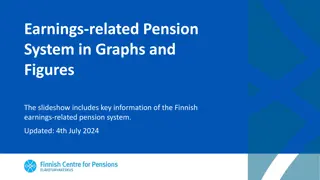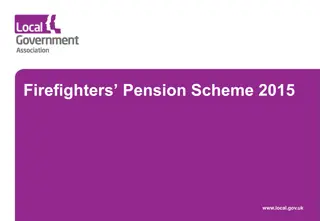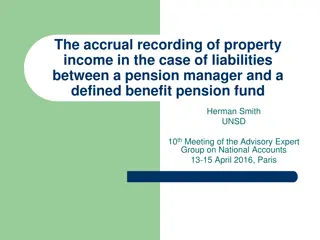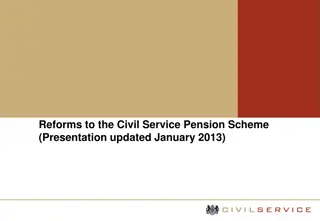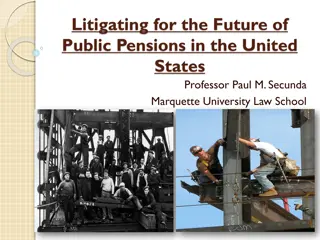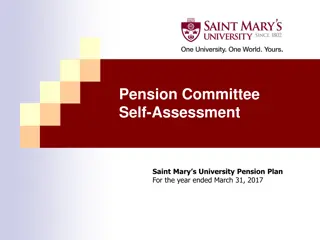Commencing a Pension: How Trustees Maximize Benefits
The presentation by Manoj Abichandani, SMSF Specialist from UNSW, delves into key aspects of commencing a pension. Topics covered include understanding pensions in retirement, setting up pension plans, merging pensions, transfer balance cap accounts, re-contribution strategies, and the benefits of 6-member funds. Attendees will gain insights on maximizing benefits and optimizing their pension funds.
Download Presentation

Please find below an Image/Link to download the presentation.
The content on the website is provided AS IS for your information and personal use only. It may not be sold, licensed, or shared on other websites without obtaining consent from the author.If you encounter any issues during the download, it is possible that the publisher has removed the file from their server.
You are allowed to download the files provided on this website for personal or commercial use, subject to the condition that they are used lawfully. All files are the property of their respective owners.
The content on the website is provided AS IS for your information and personal use only. It may not be sold, licensed, or shared on other websites without obtaining consent from the author.
E N D
Presentation Transcript
Manoj Abichandani SMSF Specialist (UNSW) Commencing a Pension - How to do it & What a Trustee needs to do to maximize benefits
Commencing a Pension - How to do it & What a Trustee needs to do to maximize benefits 1. What is a Pension and retirement phase 2. What to take care of when setting up a pension 3. When to merge Pensions 4. Transfer Balance Cap Account What is it? 5. Re-contribution Strategy 6. When are 6 member funds useful
House Keeping - Audio If Computer sound is not audio able 1. Phone the number on your panel 2. Enter Access Code
House Keeping Hand Out Copy of this Presentation can be downloaded From the Panel
House Keeping Questions on this Presentation If you have any Questions on this Presentation 1. Type in your questions in the panel 2. Speaker will answer all your questions after the presentation
Our Speaker Today Manoj Abichandani B. Bus. (UTS), CTA, SMSF Specialist (UNSW) He has worked in a Specialist SMSF CPA Firm for 26 years advising over 600 funds on various aspects of SMSF. Currently he works as a SMSF Technical Director for Deed Dot Com Dot Au Pty Ltd as a trainer and helps the solicitor in updating their SMSF Trust Deed. He has written Australia s first online SMSF Audit Software and where over 400 + SMSF Auditors initiated over SMSF 62,000 audits in the past year.
Legal & Financial Disclaimer & Disclosure In providing the below information, neither Manoj Abichandani (presenter) or an employee of Deed Dot Com Dot Au Pty Ltd is providing any financial or Legal advice as any Financial advice is based on the information provided by you with regard to your financial needs and objectives. The information below is intended to provide only broad, general guidelines which may be helpful in assessing and making decisions about financial products and general information which is available elsewhere that may help meet your financial needs and objectives. This material may also contain general educational topics about investing, legal and financial matters. It is most important that you understand that your actual experience will differ from these illustrations and examples. That is why you should consult an appropriately qualified financial planner, legal advisor or Estate planner, who can assess your situation with updated data and assumptions on a periodic basis. Information provided here is not intended to be investment advice or a projection of future investment performance. No one can foresee the future and, it is not a projection of the potential return of any investment, nor is it a projection of future inflation rates or the state of the world or domestic economy. You should seek the guidance of a financial or investment professional before proceeding with any investment decision or any super contribution or set up Decision. Our examples and illustration does not contain your income tax calculations and legal concepts; it does not constitute tax or legal Advice. These illustration may require the guidance of a tax, legal or accounting adviser. In creating the illustration certain assumptions were made with respect to investment returns, the economy, and home loan interest rates . The reports and graphics included are directly dependent on the quality and the accuracy of the data and assumptions (including rates of return and future interest rates) . Where future rates of return are assumed, these returns do not reflect the fees and charges associated with Investments, which would reduce the results. You are encouraged to review and consider performance information, which you can request from your investment professional and other securities advisor who may recommended asset/s that may be referenced in this material when assuming any future rates of return for any super contributions & investment. Keep in mind that past performance is not a guarantee of future results. A prospectus or PDS must be read carefully when considering any investment in securities or super contribution in a fund. No liability is assumed resulting from the use of the information contained in this financial presentation and the examples used Responsibilities for financial decisions are exclusively in hand of the viewer and not in hands of the presenter.
From 1st July 2017 -Trustees must maintain several accounts for every Member of the fund Only One Accumulation Account Multiple Pension Accounts Transfer Balance Account Only one Taxable & Tax Free Components Taxable & Tax Free Components Debits and Credits Component
What is an income stream - Pension SMSF Less than $1.7M Transfer Balance Cap Minimum Pension No Maximum Member
Pension Standards Account Based Pension Date of birth Preservation age 55 1. 2. 3. 4. 5. 6. 7. 8. Preservation Rules Minimum Pension Payment Transfer Balance Cap tax exemption Terms of the Deed Pension Agreement Binding Death Nominations Reversionary Pensions Death of the member Before 1 July 1960 1 July 1960 30 June 1961 56 1 July 1961 30 June 1962 57 1 July 1962 30 June 1963 58 1 July 1963 30 June 1964 59 From 1 July 1964 60
Pension Standards Account Based Pension (TRIS) Not in Retirement Phase 1. 2. 3. 4. 5. 6. 7. Preservation Rules Minimum Pension Payment Maximum Payment 10% Transfer Balance No tax exemption Terms of the Deed Pension Agreement Binding Death Nominations Reversionary Pensions - Cannot be Paid to Dependent Eligiblity of beneficiary is checked before it can be paid Death of the member 8.
Pension Commencement in the middle of the year 30th June 2022 1st July 2021 Preservation Age Item Age of Beneficiary Percentage factor 1) Commence Pension 2) Prepare Financial Statements 3) Value Assets on Pension date 4) Test Transfer Balance Cap 1 Under 65 4 2 65 74 5 3 75 79 6 4 80 84 7 5 85 89 9 6 90 94 11 7 95 or more 14 Half in 2021 22 Year
Transfer Balance Cap From 1st July 2021 Accumulation Phase $1.7M TBC Pension Phase (Tax Free Retirement) Pension Balances above $1.7M on 1st July 2021 or later 1) Withdraw the excess from the superannuation system 2) Leave excess in accumulation phase
$1.7M transfer balance cap - WHY The purpose of the transfer balance account is to track the net amounts transferred to retirement income phase . The transfer balance was introduced to: Limit the amount of capital that can support retirement income streams. Limits the amount of earnings that are exempt from income tax. The general transfer balance cap is $1.7m for the 2021-22 year and will be indexed to CPI (in $100,000 increments) Operates on a system of credits and debits.
TBC Credits Section 294 15 (2) & 294-20(1) When a member receives a superannuation income stream that is in the retirement phase any amount which are in pension phase (superannuation income streams) for the member as on 30th June 2017 or reversionary income streams commenced between 1st July 2016 and 30th June 2017; any amount which commences a pension (superannuation income stream) on or after 1st July 2017 or a reversionary income stream on or after 1st July 2017; any amount of excess transfer balance earnings of the fund that accrue on any excess transfer balance amounts; any payment in respect of LRBA from 1st July 2017, that increases the value of retirement phase income stream (Section 294-25(1) & 295- 55(1) of ITAA 1997); any amount of income stream gained due to Family law payment splits under part VIIIB of the Family Law Act 1975 under a court order; any amount of death benefit income streams being paid to the member.
TBC Debits Section 29475 & 294-80 any amount on income stream which is reduced by commuting it into a superannuation lump sum; any amount of structured settlement (payment for a personal injury the individual has suffered and is defined in section 292-95 of the ITAA 1997) an individual receives (including those received prior to 1st July 2017 remaining in the fund) and contributes (usually within 90 days) towards their superannuation interests; any amounts lost by the fund due to losses due to fraud and void transactions and payments required to comply under the Bankruptcy Act 1966; any amount of income stream lost due to Family law payment splits under part VIIIB of the Family Law Act 1975 under a court order; any amount of the income stream which is no longer in retirement phase (from the time & value at which the superannuation income stream stops) and fail to comply with the pension standards (e.g. no minimum amount paid); any amount of write off of any excess transfer balance where excess cannot be reduced or where the regulator issues a determination to crystallise the amount of the members excess amount.
When you die (Not if) you have to leave your pension behind
How the transfer balance cap works for death benefits? SISR 6.21 : If you have a superannuation interest when you die, your death creates a compulsory cashing requirement for the superannuation provider - to your beneficiaries or to your legal personal representative as soon as practicable. For dependant beneficiaries, superannuation death benefits can be cashed: SISR 6.21 (2) (a) as a superannuation lump sum that is paid out of the superannuation system, SISR 6,21 (2) (b) as death benefit income streams that are retained in the superannuation system (from 1 July 2017 such superannuation income streams must also be in the retirement phase), or a combination of the two.
Reversionary Pensions Vs Non-Reversionary Pensions Reversionary beneficiary must be to a dependent of the pensioner Pensioner has to decide Must Automatically revert to beneficiary Which one is better Client circumstances Reversionary Pension is NOT always better If there is no reversionary beneficiary Benefits can be paid as a Lump Sum or Pension or both Question: Can a Reversionary beneficiary be replaced or nominated later
Reversionary Pensions or BDBN Reversionary Pensions Vs BDBN Reversionary Pensions controls only the Retirement Phase BDBN controls the Accumulation Account some BDBN can also suggest that benefits should be paid as a pension Reversionary Pensions AND BDBN Both Required when there are pension and accumulating assets
Non Dependent can only be paid a Lump Sum Death Benefit Lump Sum Member of the fund Non -Dependent of the Member Adult Children
How dependent get affected by Balance Transfer Cap - Section 294 -25(1) of ITAA Reversionary beneficiary Death Benefit Pension Member of the fund Dependent of the Member
How dependent get affected by Balance Transfer Cap - Section 294 -25(1) of ITAA Commute own Pension and retain in Super Reversionary beneficiary Death Benefit Pension Cannot commute Deceased Pension & retain in Super Member of the fund Commute Own Pension & Withdraw as Lump Sum from Super Commute Deceased Pension & Withdraw as Lump Sum from Super
Death of a Member Example Mike dies with $500K in Pension Martha has $1M in her pension Account(commenced pension with $1.6M in 2019) Martha can Convert her account to accumulation TBA - $1M to accept reversionary pension 1) Withdraw 100 % of Mike s amount 2) Commute and withdraw her pension account by $500K
Taxable and Tax Free Component Taxable Component Tax Free Component Concessional Contributions Income of the Fund Non - Concessional Contributions Taxed @ 17% (15% Plus ML) in the hands of non-dependents Tax Free in the hands of non-dependents All income is Taxable component in Accumulation phase and Proportionate in Pension Phase All pensions withdrawals are in proportionate
Re-contribution Strategy Withdraw Taxable Component and Contribute it as Non-Concessional Contributions Challenges : - Preservation Age - Date of commencing of Pension - Amount which can be contributed back in Super - $110,000 - Bring forward rule $330,000 - Age barrier for non-concessional contribution - Total Superannuation Balance of the member
Re-contribution Strategy Mike commences a pension with $1M - at age 61 100% in Taxable Component no dependents 63 64 65 66 67 68 61 62 $330K Non Concessional Contribution Must withdraw and re-contribute and commence a 2nd Pension with 100% tax free component If higher balance ; spouse with lower balance then contribute for them
Re-contribution Strategy Change Taxable / Tax Free Components Example: Member Balance $1.0M all taxable component 1. Partially commute Accumulation withdraw $330K 2. Commence Pension 1 with $670K with taxable component 3. Contribute non-concessional $330K (Tax free Component) and Commence Pension 2 4. Partially commute Pension 1 and then re-contribute and start Pension 3 5. Optional : Merge Pension 2 & 3
Running Pension with Accumulation Accounts in an SMSF Accumulation Account of the Member Pension Account of the Member No Limit Commenced With $1.7M Taxable & Tax Free Components
Section 295 -390 Income from Assets used to meet current Pension Liabilities A proportion of the ordinary income and statutory income of a complying superannuation fund that would otherwise be assessable income is exempt from income tax under this section. Average Value of Current Pension Liabilities Average Value of Superannuation Liabilities Law does not prescribe how Average has to be calculated Can be -Daily - Monthly -Quarterly Subject to manipulation by Actuaries = proportions are different from each Actuary
Each client needs are unique 1. What does the client want ? no two clients are the same 2. What are the taxable / tax free components of each pension? 3. Are there any Dependents who can be reversionary beneficiaries? Can they re-contribute post 30th June 2022 Has bring forward rule been triggered in the previous two years? 4. 5. After first one s death does the survivor wants to retain money in super or withdraw? 6. Does the fund own Properties in the fund (Lumpy Assets)? 7. Are there Loans (LRBA s) in the fund which may have to be paid out? 8. Has the fund invested in Private companies or Pre- 99 Trusts?
Are you Talking to your clients? Large SMSF s will pay tax as some money will be in Accumulation Phase or Client wealth may exit superannuation system sooner or later Increase activity in Discretionary Trusts and other tax structures like companies structures Re-contribution Strategy may not be possible because Total Superannuation Balance will restrict the amount which can be contributed in Super Higher tax will be paid by non-dependents on death of parents because Not all assets will be supporting a tax-free component pension Higher taxable component in Death Benefit Lump Sum payments
Mental Capacity Can make decisions only if Mentally capable = Financial Power of Attorney If Mental Capacity is Lost Application in the guardianship tribunal Legal Costs Some Hard Wire clauses in the SMSF deed for early withdrawal Terminal illness Entering nursing Home Doctors decision based on Mental Health
Are you talking to your clients? Withdrawal from Superannuation System Survivor of Couple Single member fund has only Adult Children Lumpy Assets in the fund High Taxable component Income outside of Super can also be tax free Say up to $40K per year Discretionary Trust also offers asset protection Insurance Bond Tax Free after 10 Years Just spend the money
Are you talking to your Clients? Accumulation Account increases taxable component 6 Member funds SMSF for Adult Kids Example: Fund Balance $5M husband and wife Pension $3.4M withdraw $1.6M 1. Invest $280K outside SMSF 2. $330K X 4 = $1.32M two kids both are married 3. Set up 2 new funds 4. Contribute $330K for each couple as non-concessional contribution 5. Since you are also members (Total 4 members in each fund) you can control the fund for your Children 100% $3.4M Pension Fund 100% $5M SMSF Post Strategy 4 Members with $330K Each Tax Free Component
Questions Time Manoj Abichandani B. Bus. (UTS), CTA, SMSF Specialist (UNSW) He has worked in a Specialist SMSF CPA Firm for 26 years advising over 600 funds on various aspects of SMSF. Currently he works as a SMSF Technical Director for Deed Dot Com Dot Au Pty Ltd as a trainer and helps the solicitor in updating their SMSF Trust Deed. He has written Australia s first online SMSF Audit Software and where over 400 + SMSF Auditors initiated over SMSF 62,000 audits in the past year.
For further Enquires please visit our websites: www.trustdeed.com.au www.onlinesmsfaudit.com.au www.justsign.com.au and chat with our agent. Alternatively, you - contact us 0296844199 or Email us at sales@trustdeed.com.au sales@onlinesmsfaudit.com.au sales@justsign.com.au
